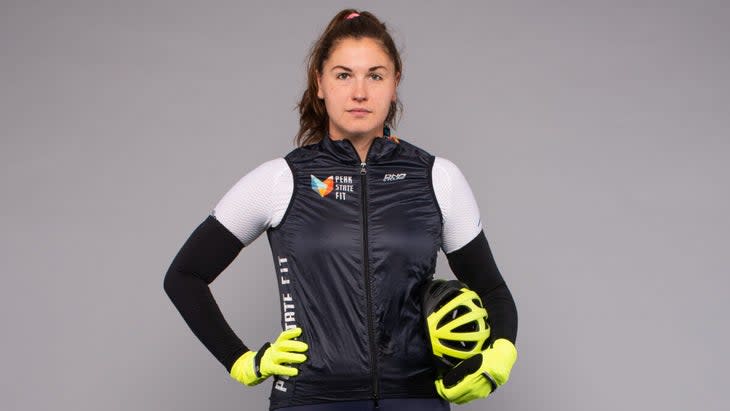What to Wear for Bike Rides, by Temperature
This article originally appeared on Triathlete
Trying to figure out what to wear for a bike ride can sometimes be more challenging than the ride itself. Raise your hand if you've ever sent this text to your training buddies:
Hey, what are you wearing for the ride today? I don't want to be too hot or too cold.
A lot of us have done this, and it's completely understandable – biking is likely the most difficult of the three triathlon disciplines to dress appropriately for both in and out of a race.
When climbing uphill, you'll exert more energy, keeping you nice and warm and sweaty. What goes up, must come down, though, and hitting a descent can lead to that sweat turning to frost quite quickly. Dressing to stay comfortable for an entire ride is an art.
RELATED: What to Wear for Open-Water Swimming (Even When it’s Cold)
What to Wear on a Bike Ride: Cold

When gearing up for a cold training ride, you have more freedom in your clothing choice. When racing in the cold, you'll want to take a totally different approach to save time transitioning from swim-to-bike while still putting on necessary warm gear. Here, we're addressing what to wear during a cold training ride.
When it's chilly out, it's nearly impossible to overdress on the bike. Standing still before the ride may feel tolerable, but it's key to remember that even when it isn't windy, it will feel chillier and windier once you start pedaling.
You'll want to invest in a pair of fleece-lined long cycling bibs (or put leggings over cycling/tri shorts for a DIY version of this) and a thermal cycling jacket and/or jersey at the minimum. You can again opt for a DIY setup by wearing a thermal, wicking run top underneath a short-sleeve jersey and layering with any waterproof, thermal shell.
Toes and fingers are often the first parts of the body to go numb in the cold; socks and thick over-shoe booties and padded full-finger gloves are necessary pieces to any Jack Frost cyclist out there. If your ears also tend to get chilly, a skull cap beneath the helmet is another critical piece to invest in.
RELATED: Ask A Gear Guru: What Are the Best Winter Cycling Clothes?
What to wear on a bike ride: Temperate

Nothing says "triathlon season is coming" quite like those early spring rides that start out a bit nippy in the morning and end in the warm midday sun.
Don't shed all those layers just yet, no matter how tempting it may be. Remember: you'll always feel colder once you start riding.
To combat that morning frostiness, consider a pair of over-shoe toe covers to block the wind. Wool socks will also keep toes and ankles toasty.
Full-finger gloves are still a go-to for temperate weather. There is nothing worse – or less safe – than not being able to feel your hands for shifting, braking, or signaling throughout your ride. If needed, tuck some half-finger gloves into your jersey for when the sun makes an appearance.
Socks, arm warmers and a light vest will keep your core insulated without overheating you. A cycling base layer top, which is a breathable, light tank top to go beneath the bib straps, will help wick sweat away from the core as well.
RELATED: How to Find the Right Bike Shorts for You
What to wear on a bike ride: Warm

All triathletes live for the days when they can finally feel the sun on their legs, arms, and back during a long day in the saddle.
Blissfully, little bike apparel is needed when the temperature hits the mid-70s Fahrenheit or higher. A breathable bike jersey made from wicking fabric is the ideal choice. Pair that with standard cycling bibs or tri shorts, and your outfit is nearly ready to go. Socks are optional as it warms up – we are triathletes, after all. No socks is kind of our thing,.
We also recommend including half-finger gloves on training rides. These gloves improve grip on shifters and brakes and are an added layer of protection should you take a fall – no one needs road rash on their hands.
RELATED: Triathlete's Women's Summer Cycling Clothing Roundup, Triathlete's Men’s Summer Cycling Clothing Roundup
No matter the weather, if you decide to wear a tri suit on race day instead of the bike clothes you wear in training, do at least three workouts in your tri suit so that you can identify any issues that may arise. Nothing is worse than discovering your chamois is unsatisfactory mid-race, or that the seams you could ignore in the dressing room at the tri shop are suddenly chafe-tastic at mile 100 of an Ironman. Remember the cardinal rule: Nothing new on race day!
RELATED: How To Choose The Perfect Tri Suit
For exclusive access to all of our fitness, gear, adventure, and travel stories, plus discounts on trips, events, and gear, sign up for Outside+ today.

